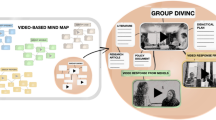Abstract
Collaborative learning (CL) processes are not always effective and inadequate design of CL scenarios is one of the main causes of its failure. Designing CL scenarios is a complex task, since it involves countless requirements and constraints that affect the learning process. A previous study showed that educators, in general, perform an inappropriate design of CL scenarios—failing to specify essential parameters and processes, mainly regarding the guidance of the learners’ actions and the evaluation of their learning. This indicates the need to provide educators with proper support and guidance. This study is particularly interested in providing a computational infrastructure to support and guide educators throughout the design process. The proposed infrastructure was evaluated through a case study with a sample of professors at a university in real situations of group work design in their face-to-face undergraduate courses. The results showed that, for this sample of educators, the infrastructure was able to expose them to relevant design parameters, supporting them in their specification and helping them to understand these parameters. Therefore, the infrastructure shows potential to prevent CL scenarios from being inappropriately and inefficiently structured.





Similar content being viewed by others
Availability of Data and Material
Not applicable.
Code Availability
Not applicable.
References
Kimble C, Hildreth P, Bourdon I. Communities of practice: creating learning environments for educators, vol. 1. Charlotte, NC: Information Age Pub; 2008.
Dillenbourg P, Baker M, Blaye A, O’Malley C. The evolution of research on collaborative learning. In: Spada E, Reiman P, editors. Learning in humans and machine: Towards an interdisciplinary learning science. Oxford: Elsevier; 1996. p. 189–211.
Isotani S, Mizoguchi R, Isotani S, Capeli OM, Isotani N, Albuquerque AR, Jaques P. A Semantic Web-based authoring tool to facilitate the planning of collaborative learning scenarios compliant with learning theories. Comput Educ. 2013;63:267–84.
Isotani S, Mizoguchi R, Inaba A, Ikeda M. The foundations of a theory- aware authoring tool for CSCL design. Comput Educ. 2010;54:809–34.
Dillenbourg P. Over-scripting CSCL: The risks of blending collaborative learning with instructional design. Three worlds of CSCL. Can we support CSCL? https://telearn.archives-ouvertes.fr/hal-00190230. Accessed 25 Sept 2021
Strijbos JW, Martens RL, Jochems WMG. Designing group based learning: six steps to designing computer-supported group based learning. Comput Educ. 2004;42:403–24.
King A. Scripting collaborative learning processes: a cognitive perspective. In: Fischer F, Kollar I, Mandl H, Haake JM, editors. Scripting computer-supported collaborative learning. Computer-supported collaborative learning, vol. 6. Boston, MA: Springer; 2007. p. 13–37.
Battou A, Baz O, Mammass D. Toward a virtual learning environment based on agile learner-centered design. Intell Syst Comput Vis. 2000. https://doi.org/10.1109/ICMCS.2016.7905666.
Kaendler C, Wiedmann M, Rummel N. Teacher competencies for the implementation of collaborative learning in the classroom: a framework and research review. Educ Psychol Rev. 2015;27:505–36. https://doi.org/10.1007/s10648-014-9288-9.
Bennett S, Agostinho S, Lockyer L. Technology tools to support learning design: Implications derived from an investigation of university teachers’ design practices. Comput Educ. 2015;81:211–20. https://doi.org/10.1007/s10648-014-9288-9.
Barkley EF, Major CHK, Cross KP. Collaborative learning techniques: A handbook for college faculty. 2nd ed. San Francisco: Jossey-Bass; 2014.
Höver KM, Mühlhäuser M. Can We Use S-BPM for Modeling Collaboration Scripts? In: Zehbold C, editor. S-BPM ONE - Application Studies and Work in Progress; 2014. https://doi.org/10.1007/978-3-319-06191-7_13
Clement M, Vandeput L, Osaer T. Blended learning design: a shared experience. Procedia: Soc Behav Sci. 2016;228:582–6. https://doi.org/10.1016/j.sbspro.2016.07.089.
Ruys I, Keer VH, Aelterman A. Student teachers’ skills in the implementation of collaborative learning: a multilevel approach. Teach Teach Educ. 2011;27:1090–100. https://doi.org/10.1016/j.tate.2011.05.005.
Gillies RM, Boyle M. Teachers’ reflections on cooperative learning: issues of implementation. Teach Teach Educ. 2010;26:933–40. https://doi.org/10.1016/j.tate.2009.10.034.
Chikh A. A general model of learning design objects. J King Saud Univ Comput Inf Sci. 2014;26:29–40. https://doi.org/10.1016/j.jksuci.2013.03.001.
Oliveira EW, Borges MRS. How educators design group learning scenarios in higher education? In: International Conference on Information Technology Based Higher Education and Training; 2019. https://doi.org/10.1109/ITHET46829.2019.8937375
Prieto LP, Asensio-Pérez JI, Muñoz-Cristóbal JA, Dimitriadis YA, Jorrín-Abellán IM, Gómez-Sánchez E. Enabling teachers to deploy CSCL designs across distributed learning environments. IEEE Trans Learn Technol. 2013;6:324–36. https://doi.org/10.1109/TLT.2013.22.
Oliveira EW, Borges MRS. Supporting educators to design collaborative learning scenarios. In: International Conference on Computer Supported Education; 2021. https://doi.org/10.5220/0010458700950103
Yin RK. Case study research design and methods. 5th ed. Thousand Oaks, CA: Sage; 2014.
O’Donnel AM, Dansereau D. Scripted cooperation in student dyads: a method for analyzing and enhancing academic learning and performance. In: Hertz-Lazarowitz R, Miller N, editors. Interaction in cooperative groups: the theoretical anatomy of group learning. Cambridge: Cambridge University Press; 1992. p. 120–41.
Hernández-Leo D, Villasclaras-Fernández ED, Asensio-Pérez JI, Dimitriadis Y, Jorrín-Abellán IM, Ruiz-Requies I, Rubia-Avi B. COLLAGE: A collaborative Learning Design editor based on patterns. Educ Technol Soc. 2006;9:58–71.
Jonassen DH, Tessmer M, Hannum WH. Task analysis methods for instructional design. 1st ed. Mahwah: Lawrence Erlbaum Associates; 1999.
Challco GC, Bittencourt II, Isotani S. Computer-based systems for automating instructional design of collaborative learning scenarios: a systematic literature review. Int J Knowl Learn. 2016. https://doi.org/10.1504/IJKL.2016.084745.
Funding
Not applicable.
Author information
Authors and Affiliations
Corresponding author
Ethics declarations
Conflicts of Interest
On behalf of all authors, the corresponding author states that there is no conflict of interest.
Additional information
Publisher's Note
Springer Nature remains neutral with regard to jurisdictional claims in published maps and institutional affiliations.
This article is part of the topical collection “Computer Supported Education” guest edited by James Uhomoibhi and Beno Csapó.
Rights and permissions
About this article
Cite this article
Oliveira, E.W., da Silva Borges, M.R. Analyzing a Computational Infrastructure for Supporting the Design of Group Learning Scenarios. SN COMPUT. SCI. 3, 265 (2022). https://doi.org/10.1007/s42979-022-01136-7
Received:
Accepted:
Published:
DOI: https://doi.org/10.1007/s42979-022-01136-7



